|
I’ve been
smitten with the Ruger Mini-14
since its introduction in 1974, when I was but a young pup fresh
out of the city. Like
thousands of other folks, I was enamored with its stocky lines
and short barrel, reminiscent of the M1 Garand and M1 Carbine of
WWII fame that Bill Ruger had loosely
modeled it after. Boasting
twice the power of the .30 carbine cartridge, the .223 round
raised the new Mini-14 to the level of first class man-stopper
and amply adequate medium range deer rifle.
The only faults that I and others seemed to be able to
find with it, were an often overly heavy 8 pound trigger, the
difficulty of mounting a scope, and what could only be described
as the Mini’s mediocre accuracy.
For clumping shots into the vital zone of bad guys at
combat ranges – essentially from point blank on out to 70 or
80 yards – or for hours of fun plinking, it was certainly
plenty accurate enough. A
cool head, controlled target acquisition and sight picture are
far more of a factor than firearm accuracy under such
circumstances. On
the other hand, as soon as one started trying to hit small game,
or to take shots past the hundred yard mark, the results were
likely to prove less than satisfying.
While sales never slowed down, word of 4 to 5” groups
at 100 yards with some guns did a lot to dampen buyer
expectations.
The release in
1982 of the Mini-14 Ranch rifle
was certainly a first step in the direction of a remedy.
Putting glass on the carbine was essential to milking any
inherent accuracy potential, and the Ranch gratefully featured a
receiver with an integral scope base that made solid scope
mounting a certainty. The
triggers, too, seemed more likely to break lighter, sometimes at
as little as 5 1/2 pounds. Nevertheless,
it wasn’t until the 2008 release of the 580 series Mini-14
that the greatest handicap to Mini accuracy was addressed, with
a switch to a heavier profile, tapered barrel instead of what
are now referred to as the pre-’08 “pencil barrels.”
Long before Ruger
began to address the issue, gunsmiths and home-tinkerers were
hard at work trying to figure out the reasons for the larger
than desired groups obtained, and the possible remedies.
I’ve read much speculation on the forums that the
barrel forging process may itself be a cause of stress, while
other commentators dispute this.
Certainly the lightweight tubes have proven susceptible
to what’s known as vertical stringing, getting worse as the
barrel heats up as a result of rapid fire.
Harmonic vibration also seems to have been a factor, with
some shooters reporting decent improvements in accuracy simply
by adding a muzzle break, flash hider or some other muzzle
weight. Replacing
the standard barrel with a heavier, target quality one seemed
the most effective solution, though it necessitated professional
installation and the widening of the barrel channel of the
factory wood stock. One
of the first companies to specialize in such work was Accuracy
Rifle Systems in Texas (not to be confused with Accuracy Systems
Inc. in Colorado, who are still in the business of custom
Minis). ARS was a
small but highly regarded operation that appears to have stopped
taking orders since the founder’s health problems, and
you’ll find photos here of their standard package with a
crowned bull barrel – in this case a full 24” long – glass
bedded and featuring a trigger job.
Much as I loved this particular arm, I’ve since traded
it to a buddy in Arizona, having found an inexpensive way to get
an accurate Mini without the daunting weight.
Worth a pretty penny, the ARS served as the benchmark
against which any others would be measured. My replacement is the test rifle for this article, a 580
series tactical model flaunting a hugely improved trigger,
my preferred 16” length barrel in the improved tapered style,
and most importantly a “Har-Bar” accurizer barrel strut
fitted underneath.
I’d heard a lot
about the Har-Bar by Rogco, reputed to drastically improve
groups. Attaching
firmly to both the barrel and the fore-end gas block, the high
grade bar was designed to eliminate the problematic barrel
“bend” or “whip” as well as to act as a heat synch.
An email went off, and within a week I had a Har-Bar and
accessories ready to try. Installation
was a breeze, and within ten minutes I was finished and admiring
the tactical Mini’s new long-toothed appearance.
I set out to see if a lighter weight Mini with the shorty
barrel could hold its own against the custom bull barreled ARS
gun, as well as how much improvement we could get over the newer
as well as older unaltered Rugers.
In this experiment, I was amply satisfied.
We began with a
2009, new out of the box tactical Mini-14, factory original
except for the wood stock to which hobbyist John Kennedy had
added a tasteful wolf motif carving (my wife thinks that the
prettier a gun looks, the better it’s likely to shoot).
Before doing anything else, I sent off the easily removed
trigger assembly to master gunsmith John Baker of Great Western
Gunsmithing for his famous $85 GunDoc trigger job.
What started out a gritty 6 pound trigger with
substantial creep, came back to me at about 3.5 pounds, nearly
as heavenly smooth as a match unit, with little creep and a
clean break. I have
what is surely an unreasonable fondness for a good trigger feel,
and now we could eliminate the trigger as a source of inaccuracy
before doing any comparative tests.
Thank you, Gun Doc!
The 'barrel to
Bar" clamps allow maximum barrel contact for cooling as
well as secure grip and resultant harmonic dampening, made of
high strength 6061 aluminum because of its superior heat sink
capability over steel clamps.
The stiffening bar itself is made heavy wall stainless
steel tubing, with the entire package adding a mere 7 ounces to
the overall weight of the firearm.
Less than half a pound, compared to the several extra
pounds the ARS bull barreled rifle carried.
Price-wise, adding a custom bull barrel to a Mini adds
from $600 to $1200 to the cost, whereas the Har-Bar runs only
only $159 complete. The
proof, of course – as my late Mama used to say – is in the
puddin’. And with
the Har-Bar, you won’t come away dissatisfied.
Initial shots
were taken offhand with open sights, just to see if there would
be a noticeable difference, and indeed there was.
My favorite glass sights on multi-purpose carbines are
variables that can be cranked up for long shots, but turned down
to minimal magnification for fast moving targets, short range
hunting or potential close quarters combat, so we first fired
some impressive-enough groups with both a Burris 1.5-4.5x
compact and a vintage Leupold 2-7X scope before mounting a 4-12X
Bushnell for the real accuracy test.
While I can sometimes be pretty good at snap shots, for
really wringing out an arm's long range performance I enlisted
the connivance and assistance of my old friend and president of
the local gun club, Stanley Radvillas. We took advantage of the benches and targets at the excellent
free gun range that he and his father Marden helped provide.
One thing we
found out right away was that the Ruger now grouped nearly as
well after firing a quick full clip as it did from a cold
barrel, leading one to think that the reputed heat sink feature
works. Further indication followed the firing a quick clip of ammo,
with the Har-Bar was actually a substantial amount hotter than
the barrel itself. The
biggest surprise was that all types of ammo we had on hand, from
spurious handloads to PMC soft points and the much maligned Wolf
brand, produced comparable groups now... though the Wolf and PMC
clusters fell nearly 4” lower, requiring a different point of
aim depending on what one planned to shoot or hunt with.
Results?
Prior to installation of the bar, the 16” Mini averaged
around 3” at 100 yards from a (barely workable!) modified
rest. Equipped with
the Har-Bar, this same tactical Mini-14 averaged a little under
2”, with the tightest group being just over 1”.
That’s a fair amount of improvement, and twice as good
as the earlier models I’ve owned.
And from what I hear, the results are even more dramatic
when the Har-Bar is added to the older thin barreled Minis,
series 180 and before.
For the sake of
comparison, the custom ARS Mini with it’s weighty 24” bull
tube shot 1” pretty consistently, with Stan’s tightest being
just over 3/4”. That’s
not a lot of difference in capabilities, for the added poundage
and nearly twice the cost.
It goes without
saying that the same level can be matched by many of the better
AR-15s right off the shelf, but for Mini lovers that was never
the point. While I
love the menacing post-apocalyptic shadow looks of my “black
rifles,” they can’t substitute for the Mini’s nostalgic
WW11 combat looks, its durable mechanism and genuine wood
furniture.
With the recent
release of Ruger’s Mini-14
Target Model with its adjustable harmonic balancer,
there’s now an increased accuracy factory model, albeit as
hefty as a 10 pound sack of sugar, and in a configuration more
suited to long range target or varmint shooting rather than the
handy generalist that the lighter models were designed to be.
By adding a Har-Bar or similar device, even to an older
pencil-barreled Mini, one can enjoy tighter desired groups while
retaining the carbine’s quick handling characteristics.
And for those who like, their bar can be fitted with a
clamp-on bipod, or with accessory clamps for tactical
flashlights, lasers and such.
Best deal of all
may be Roger’s old fashioned, no questions asked, money back
guarantee. If for
any reason one wishes to, they can return their Har-Bar for a
full refund. I, for one, will not be returning mine!
To read more
details or testimonials, or to order, go to: http://www.rogco.biz.
And you can
contact Roger by email at rogcous@sbcglobal.net
or by phone at: (414) 755-9033.
For outstanding
trigger work, bedding and crowning on Mini-14s as well as
AR’s, or to read about the GunDoc’s other services, go to: www.greatwestgunsmithing.com.
John can be
reached at:
Great West
Gunsmithing
1338 Franklin
Street NW
Salem, OR 97304
gundoc@comcast.net
Jesse
L. "Wolf" Hardin
Jess
Hardin
is an amateur historian and author, living a pioneer lifestyle
on an isolated ranch seven river crossings from the nearest
road. He’s earned praise for his sporting articles from
renowned writers like John Taffin and Dennis Adler, from
students and housewives for his self-help pieces, and from
literary gadflies for his commentaries on life in the modern
West. Personally
signed copies of his full-color book, Old
Guns & Whispering Ghosts, are again available from
the author, recounting the tale of the historic Western period
1866-1916 through stories of its colorful firearms. He welcomes
your suggestions and comments: mail@oldgunsbook.com.
  
Got something to say about this article? Want to agree (or
disagree) with it? Click the following link to go to the GUNBlast Feedback Page.
|
|
Click pictures for a larger version.
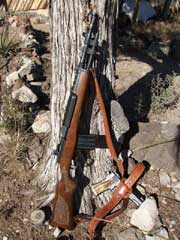
The ever popular Ruger Mini-14 is even more of a
peach with an accuracy enhancing barrel strut like the Har-Bar.
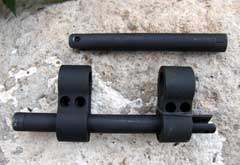
The Har-Bar comes in sizes for every barrel length,
and both types of barrel contour.
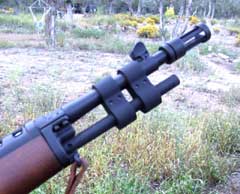
The Har-Bar takes only a few minutes to install, and
then is ready for shooting.
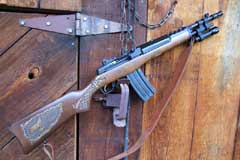
Accessories for the Har-Bar include bipods, laser
mounts, and a flashlight mount like the one shown.
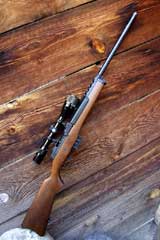
This custom Mini has a 24" bull barrel, bedding
and match trigger by Accuracy Rifle Systems... our heavy,
high-dollar standard to measure all others against.
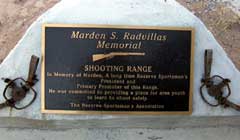
For testing purposes, we took our Minis to the Catron
County Gun Range, dedicated to Marden Radvillas who helped
make this excellent rural facility a reality.
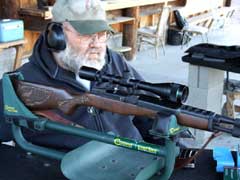
My buddy Stan is Marden Radvillas' son, from a family
known for sharpshooters.
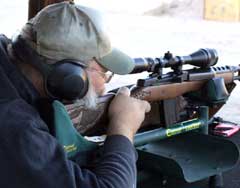
When it comes time to shoot for groups, I leave it to
Stan to see how tight we can get them.
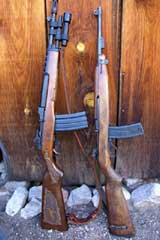
Here we see the Har-Bar equipped Mini-14 next to the
historic M1 carbine it was largely modeled after, with this
Mini being not only the more powerful but the more accurate of
the two.
|
![]()